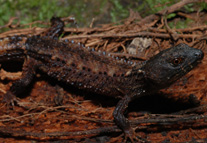Abstract
Eulimnadia Packard, 1874 is the most species rich and widely distributed genus within the Limnadiidae (Reed et al. 2015). Species identification relies primarily on egg morphology as adult morphological characters show high variability, sometimes within the same populations and hence of little use (Rabet, 2010; Rogers et al. 2012). Seven species are currently known from the Indian subcontinent (sensu Rogers & Padhye 2015) and SE Asia (Rogers et al. 2016). Of these, four species, viz. E. compressa (Baird, 1860), E. michaeli Nayar & Nair, 1968 and E. indocylindrova Durga Prasad and Simhachalam, 2004, E. azisi Babu and Nandan, 2010 are known from peninsular India (Padhye et al. 2015; Rogers & Padhye, 2015), although, much of this region remains unstudied (Padhye pers. obs.). With this background, we present a new Indian record of E. khoratensis Rogers, Dadseepai and Sanoamuang, 2016 from the Western region of Maharashtra state, India, extending its distribution a few thousand kilometers westwards.
References
Durga Prasad, M.K. & Simhachalam, G. (2004) Eulimnadia indocylindrova sp. nov. (Branchiopoda: Spinicaudata) from South India with a review of the genus Eulimnadia in Indomalayan region. In: Proceedings of the International Conference on Great Himalayas: Climate, Health, Ecology Management and Conservation. KU/AEHMS/HIRI Publ, Kathmandu University, Kathmandu, pp. 74–81.
García-Roger, E.M., Armengol-Díaz, X., Carmona, M.J. & Serra, M. (2008) Assessing rotifer diapausing egg bank diversity and abundance in brackish temporary environments: an ex situ sediment incubation approach. Archiv für. Hydrobiologie, 173, 79–88.
https://doi.org/10.1127/1863-9135/2008/0173-0079Nation, J.L. (1983) A new method using Hexamethyldisilazane for preparation of soft insect tissues for scanning electron microscopy. Stain Technology, 58 (6), 347–351.
https://doi.org/10.3109/10520298309066811Padhye, S., Rabet, N. & Ghate, H. (2015) First faunal inventory of large branchiopods (Crustacea: Branchiopoda) of Western Maharashtra, India with taxonomical and distributional comments. Zootaxa, 3904 (2), 208–222.
https://doi.org/10.11646/zootaxa.3904.2.2Rabet, N. (2010) Revision of the egg morphology of Eulimnadia (Crustacea, Branchiopoda, Spinicaudata). Zoosystema, 32 (3), 373–391.
https://doi.org/10.5252/z2010n3a1
Reed, S.K., Duff, R.J. & Weeks, S.C. (2015) A systematic study of the genus Eulimnadia. Journal of Crustacean Biology, 35 (3), 379–391.
https://doi.org/10.1163/1937240X-00002345Rogers, D.C. & Padhye, S. (2015) Review of the large branchiopod crustacean fauna of the Indian Subcontinent (Anostraca, Notostraca, Laevicaudata, Spinicaudata, Cyclestherida). Journal of Crustacean Biology, 35 (3), 392–406.
https://doi.org/10.1163/1937240X-00002327Rogers, D.C., Rabet, N. & Weeks, S.C. (2012) Revision of the extant genera of Limnadiidae (Branchiopoda: Spinicaudata). Journal of Crustacean Biology, 32 (5), 827–842.
https://doi.org/10.1163/193724012X637212Rogers, D.C., Dadseepai, P. & Sanoamuang, L.O. (2016) The spinicaudatan clam shrimps (Branchiopoda: Diplostraca) of Thailand. Journal of Crustacean Biology, 36 (4), 567–575.
https://doi.org/10.1163/1937240X-00002441Timms, B.V. (2016) A partial revision of the Australian Eulimnadia Packard, 1874 (Branchiopoda: Spinicaudata: Limnadiidae). Zootaxa, 4066 (4), 351–389.
https://doi.org/10.11646/zootaxa.4066.4.1Van Damme, K. & Dumont, H.J. (2010) Cladocera of the Lençóis Maranhenses (NE-Brazil): faunal composition and a reappraisal of Sars' Method. Brazilian Journal of Biology, 70 (3), 755–779.
https://doi.org/10.1590/S1519-69842010000400008Weeks, S.C., Brantner, J.S., Astrop, T.I., Ott, D.W. & Rabet, N. (2014) The evolution of hermaphroditism from dioecy in crustaceans: selfing hermaphroditism described in a fourth spinicaudatan genus. Evolutionary Biology, 41 (2), 251–261.
https://doi.org/10.1007/s11692-013-9265-0

